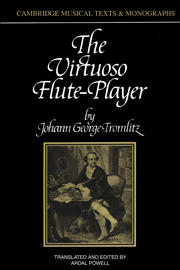Book contents
- Frontmatter
- Contents
- Translator's note
- Introduction by Eileen Hadidian
- Title in the series
- DETAILED AND THOROUGH TUTOR FOR PLAYING THE FLUTE
- Foreword
- Introduction
- 1 The flute and its character
- 2 Holding the flute, and the embouchure
- 3 Fingering
- 4 The notes and rests, their values and denominations, and the other musical signs
- 5 Time-signatures, and how the notes are divided and counted in them; the beat itself, or counting time according to an appointed tempo
- 6 Tone and pure intonation
- 7 Modern key-signatures
- 8 The articulation proper to this instrument, or the means of governing the wind suitably, as well in slow as in moderately quick movements; also called the single tongue
- 9 The technique for executing fast and very fast passages clearly and roundly; also, though improperly, called the ‘double tongue’
- 10 The ornaments
- 11 The trill
- 12 Fermatas and cadenzas
- 13 The taking of breath in flute-playing
- 14 The discretionary ornaments; or how to vary a simple melody according to the rules of harmony, and to use these variations in a good and suitable way appropriate to the material
- 15 Summary of the whole, together with a few remarks for pupils and masters
- Fingering-chart
- Select bibliography
- Index
9 - The technique for executing fast and very fast passages clearly and roundly; also, though improperly, called the ‘double tongue’
Published online by Cambridge University Press: 01 June 2011
- Frontmatter
- Contents
- Translator's note
- Introduction by Eileen Hadidian
- Title in the series
- DETAILED AND THOROUGH TUTOR FOR PLAYING THE FLUTE
- Foreword
- Introduction
- 1 The flute and its character
- 2 Holding the flute, and the embouchure
- 3 Fingering
- 4 The notes and rests, their values and denominations, and the other musical signs
- 5 Time-signatures, and how the notes are divided and counted in them; the beat itself, or counting time according to an appointed tempo
- 6 Tone and pure intonation
- 7 Modern key-signatures
- 8 The articulation proper to this instrument, or the means of governing the wind suitably, as well in slow as in moderately quick movements; also called the single tongue
- 9 The technique for executing fast and very fast passages clearly and roundly; also, though improperly, called the ‘double tongue’
- 10 The ornaments
- 11 The trill
- 12 Fermatas and cadenzas
- 13 The taking of breath in flute-playing
- 14 The discretionary ornaments; or how to vary a simple melody according to the rules of harmony, and to use these variations in a good and suitable way appropriate to the material
- 15 Summary of the whole, together with a few remarks for pupils and masters
- Fingering-chart
- Select bibliography
- Index
Summary
There has been much disagreement about this method of articulation on the flute: some accept it, and others reject it, though certainly without sufficient understanding or reason. Those who accept it say: it is not possible to execute fast passages clearly and roundly without this articulation; the others, however, maintain the opposite. We will see below who is right. Quantz was the first to treat of this matter in print, but since very few people have learned to use his manner of articulation, and to apply it properly, most people have rejected it as superfluous – though certainly prematurely – and made shift as best they could without it. That few people have been able to learn to do it right is certain, but whether the fault lies with the teacher, or the pupil, or both, may be decided at the end [of the chapter].
Although Quantz was the first to introduce this articulation generally, I do not think he was the first, at least not the only one, to discover it. As far as the use of the tongue was concerned I was groping around in the dark for a long time; though I would have been happy to be enlightened, I could find nobody to help me and put me on the right path; I felt sure that there must be certain techniques indispensable to the clear execution of fast passages, as with the single tongue, and that one should not have merely to drone the notes out with one's tongue at a standstill.
- Type
- Chapter
- Information
- The Virtuoso Flute-Player , pp. 195 - 211Publisher: Cambridge University PressPrint publication year: 1991



